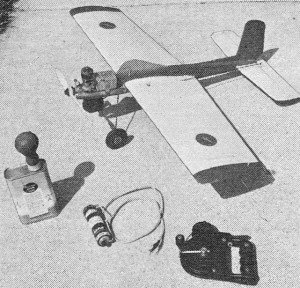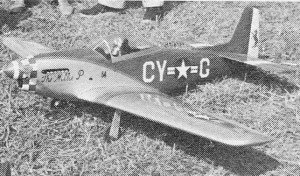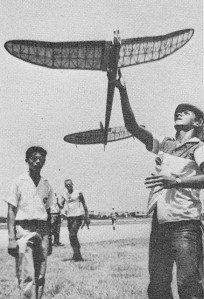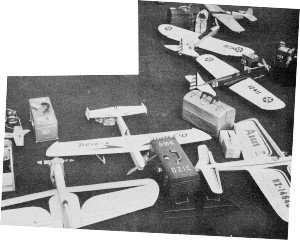|
An
extensive article introducing non-modelers to aircraft modeling
appeared in the Annual Edition of the 1962 American Modeler magazine.
15 pages were devoted to describing just about every aspect of model
building and flying - free flight gas and rubber; control line stunt,
combat, scale, and speed; helicopters and ornithopters; indoor gliders,
stick and tissue, and microfilm; even some early radio control.
In order to keep page length here reasonable (because of all
the images), the article is broken into a few pages. Pages:
|
10 & 11 |
12|
13 |
14 |
15 |16
|
17 |
18 |
19 |
20 |
21 |
22 |23
|
24 | For Non-Modelers: All About Air Modeling
20 Easy Ways to Go Crazy!

Guillows profile U-control for beginner with fuel, filter bulb,
battery, U-Reely handle; .23 power.

Ultimate in radio control is Mustang by Phil Breitling. Spans
5-1/2'; "full house" equipment. Plans used by 1961 R/C scale
winner.

"FAI Class" free flight (left) for inter-national events has
Cox .15 power.

Collection of top aerobatic Ukie stunt planes was snapped at
'61 Nats. Majority of these have, or will appear in American
Modeler.
<previous> <next>
Models have no landing gear and take off from a dolly made of
steel wire fitted with 3 or 4 model wheels. When model flies out
of dolly cradle latter rolls out of flying circle. Fuselage bottoms
have skids on bottom for landing. To maintain equal diameter
flight circles and to prevent model being whipped to higher speeds,
the flyer holds his control handle in a revolving yoke atop a pylon
pipe mounted in circle's center. Flyer has to step lively around
pylon to keep up with his model! Flying is strictly against the
stopwatch, three timers being utilized during competition flying.
Big boost to control line speed has been via Victor Stanzel's
Mono-Line control system. Unlike the two-wire, bellcrank system
popularized by Jim Walker, the Mono-Line utilizes a single wire
from handle to model. The control handle twists the wire along its
length, this twisting action turns a cam linked to a small crank
in model. Crank moves elevator push rod. Mono-Line has the advantage
of somewhat reduced wire drag because of single wire. Control is
smoother and finer and works even when line slacks off, should model
turn into the circle because of wind or instability. Recent
addition to the speed event schedule is Proto Speed. Class B engines
only are allowed and model requirements are quite different than
for standard speed types. Design must resemble a full scale airplane,
have engines enclosed, have minimum wing span of 24 in. and have
working landing gear. Model must take off on its gear; flying is
from a pylon as in regular speed. Fourteen laps are timed; current
speeds range up to 120 mph. C/L JET SPEED
- At present there are only a few practical jet engines available
to modelers. Of these, the powerful Dyna-Jet has gained the most
popularity. "Popularity" is only a relative term. Although the Dyna-Jet
has excellent performance, starts easily, is cheap to operate (straight
gasoline for fuel) it does have two shortcomings. It emits an unearthly
roar when running and gives off a great amount of heat. These qualities
are inherent in the operation of such an engine and limit its use
as a model power plant. The noise factor presents the most difficult
problem, because the minute you fire up a Dyna-Jet near a residential
area the police may appear within minutes. "Cut it out son, you've
set all the dogs to barking and baby's a'crying and the neighbors
are complaining mightily!" So Dyna-Jets can only be flown where
their noise is not objectionable. The Dyna-Jet is a scaled-down,
simplified version of the pulse jet used to power the German V-I
Buzz bombs of World War II. It is nearly two feet long, has only
one moving part, the intake valves, burns straight gas and delivers
4-1/2 plus pounds of static thrust. Starting is with an air blast
from a tire pump and spark coil ignition to light off fuel mixture.
Both are disconnected after engine starts, it will continue to run
by itself until fuel is exhausted. Its main use with models is in
the Jet speed event. It is also used to power big scale models of
jet fighters, but requires careful insulation and ventilation to
prevent fires. On speed models the engine is mounted externally
above the model airframe usually completely exposed so that neat
carries away in the air. Jet speed model construction is rugged
like prop speed jobs and size is close to Class C types-about 20"
wing span. All the rules for regular speed flying apply. Flying
is done on 70 ft. lines only. Take-off dollies are seldom used.
Since there is no prop in the way, model can slide off on its belly.
Present jet speed record is 179 plus mph, This figure has not been
approached for several years, speeds of 150 to 160 mph being usual
in competition today. This compares favorably with Class C prop-driven
model speeds. C/L ENDURANCE - Strictly
in the fad or exhibition category, control line endurance flying
has a limited appeal to most modelers. Early endurance attempts
were made with large stunt planes or converted radio control types
fitted with fuel tanks holding many quarts of fuel. Hours and hours
of flying proved that the flyer would wear out before the engine
or the model, a fine tribute to the engine makers, One major problem
was the accumulation of oil from engine exhaust which gummed up
controls, soaked through covering and weakened model structures.
Some models then collapsed in flight. All-out attempts to
boost records turned up some interesting gadgets. One system used
a standard size fuel tank in the model which was constantly refilled
through plastic tubing running along flying lines to a reservoir
at center of circle. Reservoir was fitted with a hand pump to push
fuel through tubing out to model tank. Such all out man-and-model-killing
endurance tests have since been eclipsed and sane rules for such
events have been written into the A.M.A. regulations, Engine size
is limited to .19 to .36 cu. in., flying lines must be 52'h to 70
ft. in length. Models must be heavier-than-air type, no Helium gas
bags please, and take-off weight is limited to 4 pounds including
fuel. Permanent landing gear must be used and no model parts can
be jettisoned during flight. C/L RAT RACING
- The "stock car racing" of model flying, Rat Racing is a favorite
among both contest and weekend yo-yo flyers. The idea of putting
several models into the air in the same circle and tail chasing
in a plain old-fashioned race increases the fun factor to a high
degree. Rat Race flying has grown out of the desire to simplify
Team Racing rules. This colorful T.R. event has never gained the
widespread popularity it deserves, possibly because it is complicated.
Rat
Racing, on the other hand, uses models reduced to the bare essentials.
There are no restrictions on model design except that fixed landing
gear is required, models must be rigged for counter-clockwise flight,
must R.O.G. and have engines from .15 to .40 cu. in. displacement.
The typical Rat Racer is a rugged compromise of speed job,
team racer and profile trainer types. Speeds of over 100 mph have
been reached in some racing, so models must be strongly built. Model
size varies from about 20 to 30 in. wing span. Somewhat larger than
a similarly powered speed job, the Rat Racer requires extra wing
area and length for reasonable maneuverability and good landing
and take off handling. Simplicity keynotes rat racer construction.
There is plenty of hardwood and plywood used in construction: Profile
or boxed in crutch fuselages are favored. Wings and tails are usually
solid bass and/or balsa. Thin lifting airfoils are used.
<previous> <next>
Posted December 25, 2010
|



